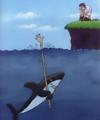On reading a couple of the posts on the forum it would appear that a floating line is the best for bass fishing, is this actually the case? To date I have only fished with an intermediate sinking line and a super fast sinking leader. Should I change this setup if I want to catch bass or does it depend on the actual location that you are fishing and the fly you are casting.
Should I keep the fly as close to the surface as possible or should I be fishing it from mid to deep water? Also, since many people on here have more experience than I, how should the line be retrieved in terms of action and speed to maximize bass interest?
Regards
Denis
What fly line for bass!
Moderators: Tanglerat, lumpy
-
petekd

- SAI Megalodon!
- Posts: 4840
- Joined: Fri May 06, 2005 5:46 pm
- Favourite Rod: ZZiplex GB3 Lite
- Favourite Reel: 7ht Mag
- Favourite Fish: Big fat botties
- Location: Cork
-
lumpy

- SAI Megalodon!
- Posts: 1474
- Joined: Mon Nov 21, 2005 6:22 pm
- Favourite Rod: conoflex nemesis plus slr
- Favourite Reel: Daiwa SL30SHV
- Favourite Fish: Bull Huss, flounder
- Location: clonakilty, co cork
i would go for a an intermediate with a sink rate of about 1 1/2 inchs per second.its the most versatile line as you can fish poppers to deep water pollack with it
shore species 2008(25):dogfish(3.1lbs), bull huss (12lb 2oz), bass, shore rockling, coalie, whiting, pollack, conger (22.4lbs),flounder, thick lipped mullet (4.8lbs),turbot,ling (11.2lbs),ballan wrasse(4.5lbs), cuckoo wrasse, pouting, poor cod, cod (9.5lbs), dab, 3 bearded rockling, long spined scorpion fish, corkwing wrasse, plaice, trigger fish, sea trout, garfish
regards neil
regards neil
-
JimH
- SAI Megalodon!
- Posts: 1106
- Joined: Thu Feb 09, 2006 11:42 am
- Location: Wexford
bass fly line - INTERMEDIATE
D
While each line has its own merits and necessary presentation properties I would recommend an intermediate as the best ‘general’ line for bass fly-fishing.
As a beginner a floating line will help with the following
· Loop visibility
· Easy lift off
· Easy to ‘track’ on the water
With and intermediate line things change slightly and become a little different
· Visibility will become more difficult
· Grip is sometimes difficult
· Lift off the water is often done through a roll and then a pick up and shoot
With sinking lines there are more changes
· Casting is kept simple with no false casting
· Rolling the line to the surface and then shooting is necessary
· Change of direction needs to be ‘planned’
Each line is necessary for proper fishing situations and each will subsequently affect what retrieve you will use and in turn what fly you will be fishing. With a floating line and a surface fly like a popper – simply lift the rod tip while tugging down with your line hand, wait for five or more seconds and repeat.
With big deceivers and the like often no retrieve is the best and simply fishing the fly on a dead drift and through the various currents will prove very effective. Make sure slack is kept to a minimum.
The clouser is probably the most used saltwater fly and one of the most if not THE most effective. By virtue of its weighted head it will sink to the bottom very quickly so a strip/stop retrieve works very well, causing the fly to move up and down.
The speed of your retrieve is dependent on many things but vary it during the day to improve your catch rate. Rapid works good some times – so does a stop start – so does a slow figure of eight – you need to decide on the day and the situation.
While each line has its own merits and necessary presentation properties I would recommend an intermediate as the best ‘general’ line for bass fly-fishing.
As a beginner a floating line will help with the following
· Loop visibility
· Easy lift off
· Easy to ‘track’ on the water
With and intermediate line things change slightly and become a little different
· Visibility will become more difficult
· Grip is sometimes difficult
· Lift off the water is often done through a roll and then a pick up and shoot
With sinking lines there are more changes
· Casting is kept simple with no false casting
· Rolling the line to the surface and then shooting is necessary
· Change of direction needs to be ‘planned’
Each line is necessary for proper fishing situations and each will subsequently affect what retrieve you will use and in turn what fly you will be fishing. With a floating line and a surface fly like a popper – simply lift the rod tip while tugging down with your line hand, wait for five or more seconds and repeat.
With big deceivers and the like often no retrieve is the best and simply fishing the fly on a dead drift and through the various currents will prove very effective. Make sure slack is kept to a minimum.
The clouser is probably the most used saltwater fly and one of the most if not THE most effective. By virtue of its weighted head it will sink to the bottom very quickly so a strip/stop retrieve works very well, causing the fly to move up and down.
The speed of your retrieve is dependent on many things but vary it during the day to improve your catch rate. Rapid works good some times – so does a stop start – so does a slow figure of eight – you need to decide on the day and the situation.